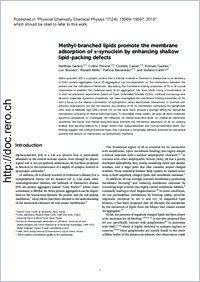Methyl-branched lipids promote the membrane adsorption of α-synuclein by enhancing shallow lipid-packing defects
- Garten, Matthias Institut Curie - Centre de Recherche - Paris - France - CNRS
- Prévost, Coline Institut Curie - Centre de Recherche - Paris - France - CNRS
- Cadart, Clotilde Institut Curie - Centre de Recherche - Paris - France - CNRS
- Gautier, Romain Institut de Pharmacologie Moléculaire et Cellulaire - Université de Nice Sophia-Antipolis and Centre National de la Recherche Scientifique - UMR 7275 - 06560 Valbonne - France
- Bousset, Luc CNRS - Paris Saclay Institute of Neuroscience - Gif-sur-Yvette - France
- Melki, Ronald CNRS - Paris Saclay Institute of Neuroscience - Gif-sur-Yvette - France
- Bassereau, Patricia Institut Curie - Centre de Recherche - Paris - France - CNRS
- Vanni, Stefano Institut de Pharmacologie Moléculaire et Cellulaire - Université de Nice Sophia-Antipolis and Centre National de la Recherche Scientifique - UMR 7275 - 06560 Valbonne - France - Biology Department, University of Fribourg, Switzerland
-
2015
Published in:
- Physical Chemistry Chemical Physics. - 2015, vol. 17, no. 24, p. 15589–15597
English
Alpha-synuclein (AS) is a synaptic protein that is directly involved in Parkinson's disease due to its tendency to form protein aggregates. Since AS aggregation can be dependent on the interactions between the protein and the cell plasma membrane, elucidating the membrane binding properties of AS is of crucial importance to establish the molecular basis of AS aggregation into toxic fibrils. Using a combination of in vitro reconstitution experiments based on Giant Unilamellar Vesicles (GUVs), confocal microscopy and all-atom molecular dynamics simulations, we have investigated the membrane binding properties of AS, with a focus on the relative contribution of hydrophobic versus electrostatic interactions. In contrast with previous observations, we did not observe any binding of AS to membranes containing the ganglioside GM1, even at relatively high GM1 content. AS, on the other hand, showed a stronger affinity for neutral flat membranes consisting of methyl-branched lipids. To rationalize these results, we used all-atom molecular dynamics simulations to investigate the influence of methyl-branched lipids on interfacial membrane properties. We found that methyl-branched lipids promote the membrane adsorption of AS by creating shallow lipid-packing defects to a larger extent than polyunsaturated and monounsaturated lipids. Our findings suggest that methyl-branched lipids may constitute a remarkably adhesive substrate for peripheral proteins that adsorb on membranes via hydrophobic insertions.
- Faculty
- Faculté des sciences et de médecine
- Department
- Département de Biologie
- Language
-
- English
- Classification
- Biological sciences
- License
-
License undefined
- Identifiers
-
- RERO DOC 328916
- DOI 10.1039/C5CP00244C
- Persistent URL
- https://folia.unifr.ch/unifr/documents/308770
Statistics
Document views: 137
File downloads:
- pdf: 362
